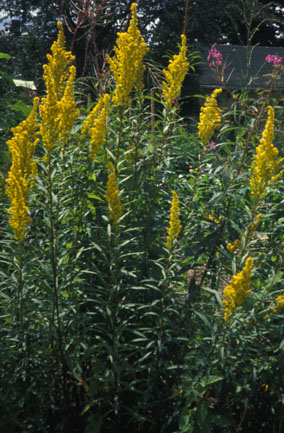
|
Goldenrod
|
| Goldenrod is a tall, handsome, blond wildflower native here, as in
most of North America. It is the State Flower of both Nebraska and
Kentucky. It is untrue that goldenrods contribute significantly to hayfever
problems. Goldenrods are in the sunflower family's
Solidago genus. They bear plumes of showy yellow flowers in late summer and fall. The
yellow tops can be used to make yellowish-tan or old-gold dyes. About
125 species of Solidago exist altogether. Compared to Back East, Seattle
is impoverished with respect to our goldenrod population; only one
species grows here wild, whereas many dozens are east of the Rockies. |
| Seattle's goldenrod is Solidago
canadensis. The epithet canadensis (of Canada) was used in a very broad sense when the plant was named in
the 1700s. A tall, robust perennial, it forms clumps which spread
wider yearly, just like fireweed and horsetail, but slower. You might
say goldenrod walks; the others run. |
| The stems are dense with numerous narrow, dark green, raspy,
notched leaves. Vivid yellow flowers of tiny size yet abundantly borne, appear
at the tops in July, August and September. Usually at least waist-high,
the tallest reach 8 feet, making a riveting display of nodding clusters of
gold. In autumn, a brownish seediness ensues, and tiny white-tufted
seeds blow about. Then the stems shrivel and die. |
| Goldenrod grows in sunny places, for the most part in the
country. You can see it in Seattle in open sunny sites along the freeway, at
Sand Point, in warehouse districts, at Seward Park, etc. It is not a garden
weed. Although the flowers are pretty, few of us plant it in our gardens; we
buy other kinds, if any. |
| A much different species worth acquiring is
Solidago odora. It is called variously the sweet, fragrant or anise-scented goldenrod. While
our native species is edible, its sap is sticky and flavor not
gratifying --there is enough rubber in the juice that people such as Thomas Edison
have tried to make goldenrod rubber-extraction profitable. Yet the
sweet goldenrod has a warm delicious flavor recalling anise or tarragon.
Sweet goldenrod also is smaller and more elegant, blooms later, is hairless,
and more floppy. Once a clump gets established in your garden, it is
carefree. You may stake or tie it if its recumbent stems bother you. The
tender young leaves can be eaten raw like those of tarragon; a tea can also
be made. |
There's just one catch. As Russian tarragon is poorly flavored
compared to French tarragon, most sweet goldenrods are not worth
eating compared to the select few. Taste before you buy. If you want to see
sweet goldenrod, Canadian goldenrod, and French tarragon, visit the
U.W. Medicinal Herb Garden. Alas, the sweet goldenrod there is the
poorly-flavored kind.
|
(originally published in The Seattle Weekly, September 1997)
Back |
|
|

